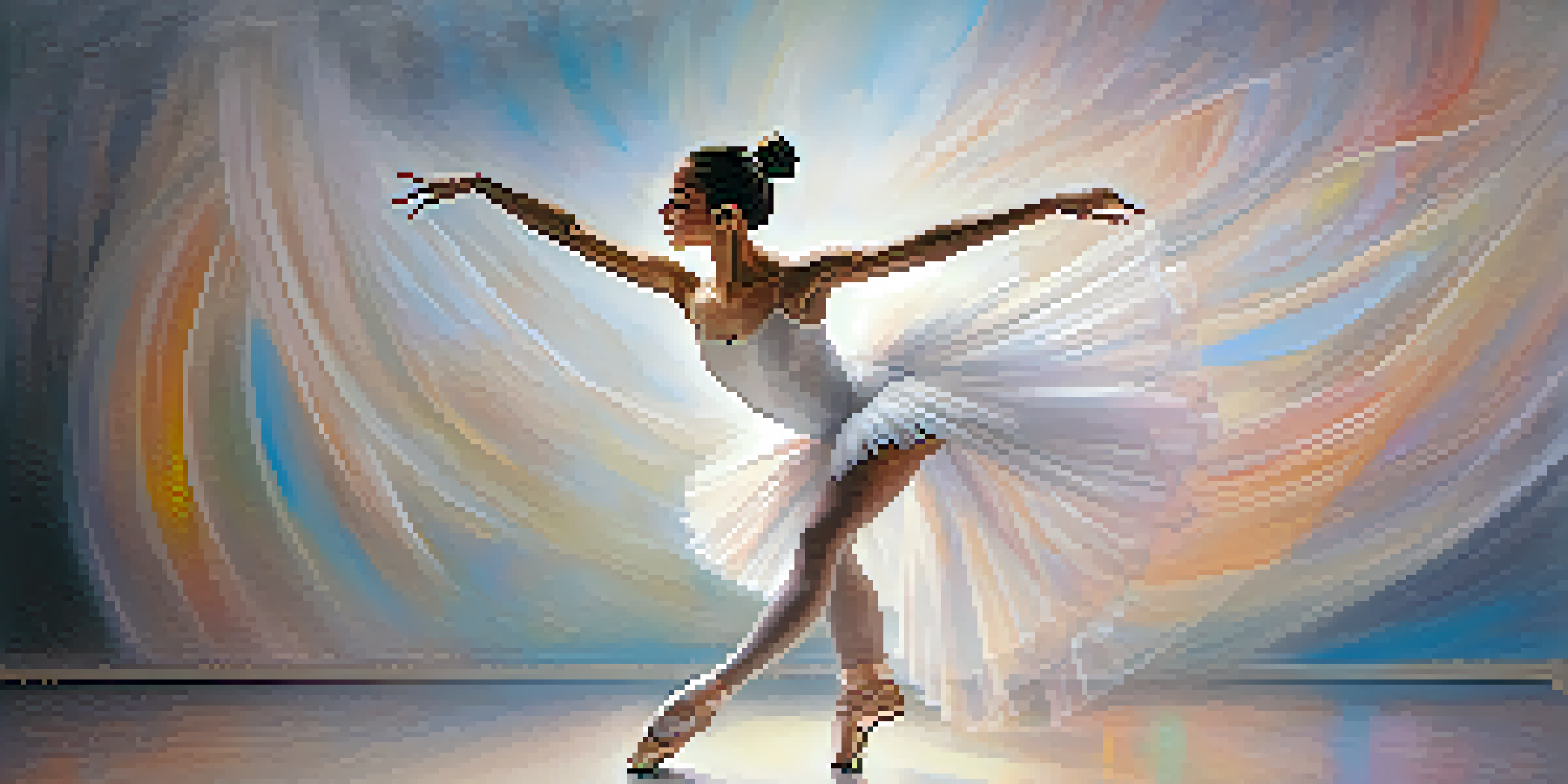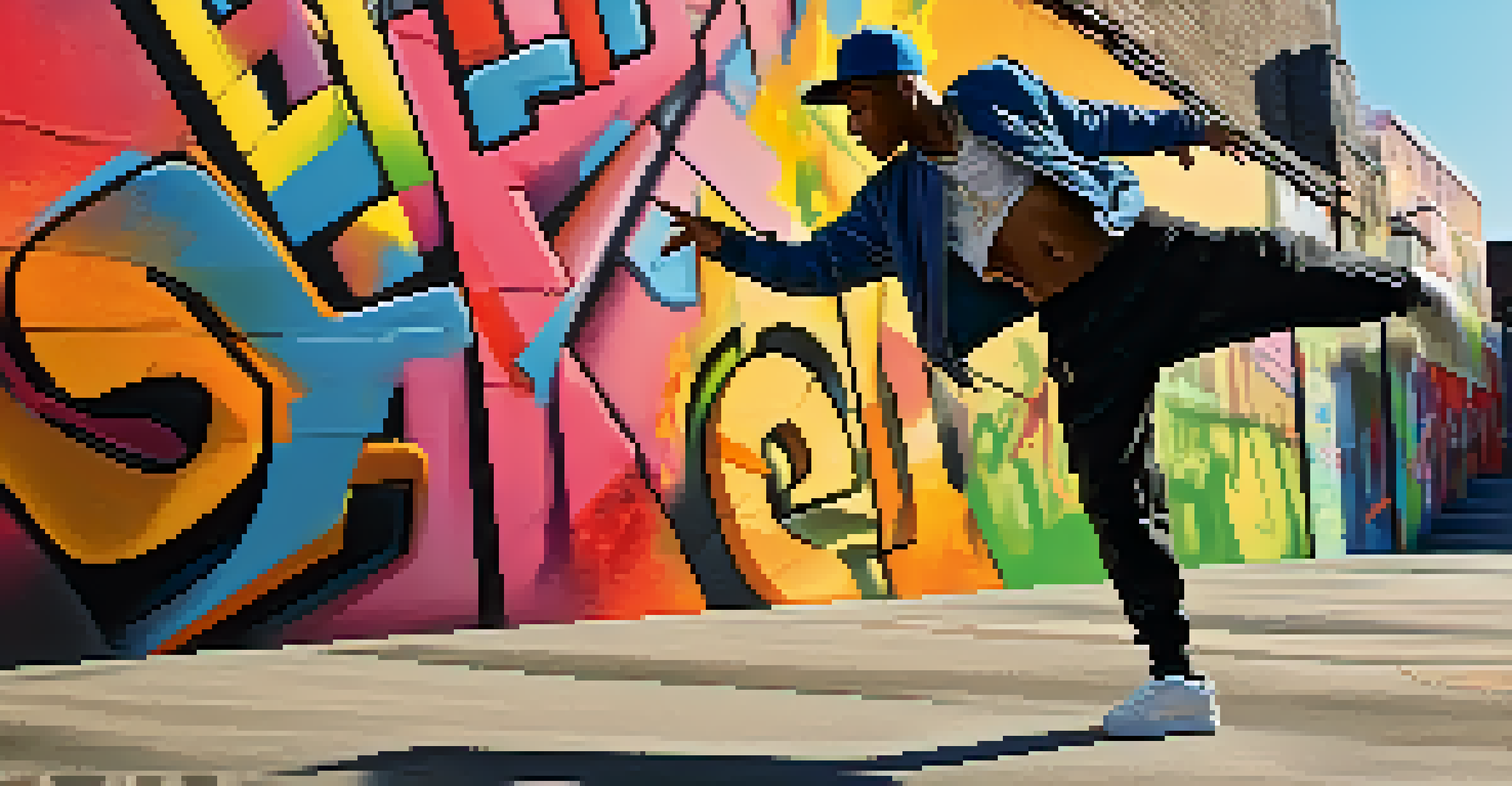The Intersection of Dance and Visual Arts in Emotional Expression

Understanding the Emotional Language of Dance
Dance, at its core, is a powerful form of emotional expression. Through movement, dancers convey feelings that words often fail to capture. This non-verbal form of communication allows audiences to connect on a deeper level, experiencing joy, sadness, and everything in between.
Dance is the hidden language of the soul.
For example, a ballet dancer might express sorrow through slow, fluid movements, while a hip-hop performer might channel anger with sharp, quick gestures. Each style brings its own emotional vocabulary, showcasing the vast range of human experience.
Ultimately, dance becomes a universal language, transcending cultural and linguistic barriers. It invites viewers to interpret and feel, creating a shared emotional experience that resonates with all.
Visual Arts: A Canvas for Emotions
Visual arts, including painting, sculpture, and photography, serve as another profound medium for emotional expression. Artists often use color, form, and composition to evoke feelings and provoke thought. A bright, chaotic painting might elicit excitement, while a muted, somber piece might evoke reflection and melancholy.

Take, for instance, Edvard Munch's 'The Scream.' This iconic artwork powerfully captures existential angst and fear through its swirling colors and distorted figure. It’s a prime example of how visual arts can encapsulate complex emotions in a single image.
Dance: A Universal Emotional Language
Dance transcends cultural barriers, allowing dancers to express a wide range of emotions through movement.
Just like dance, visual arts allow for personal interpretation, inviting viewers to engage with the emotions embedded in each piece. This invitation to explore feelings can lead to a deeper understanding of both the artwork and oneself.
The Synergy of Dance and Visual Arts
When dance and visual arts intersect, they create a rich tapestry of emotional expression. Collaborative performances often blend the two, where dancers move in response to visual stimuli, enhancing the emotional impact of both forms. This synergy allows for a multi-dimensional experience that captivates audiences.
Art is the most beautiful of all lies.
For example, a performance that incorporates projected images can amplify a dancer's movements, creating a mesmerizing interplay between dance and visual art. The visuals can serve as a backdrop that reflects the dancer's emotions, creating a cohesive narrative.
This fusion not only enriches the artistic experience but also deepens the audience's emotional engagement. It exemplifies how the combination of different art forms can lead to innovative expressions of human feelings.
Historical Context: Dance and Visual Art Collaborations
Throughout history, dance and visual arts have often intersected, reflecting cultural values and emotional expressions of the time. From ancient rituals to contemporary performances, this collaboration has played a significant role in storytelling. For instance, the Renaissance period saw elaborate stage designs that complemented theatrical dance, enhancing the overall emotional narrative.
In the 20th century, artists like Martha Graham and visual artist Isamu Noguchi collaborated to create groundbreaking performances that integrated dance and sculpture. Their works challenged traditional boundaries and explored new ways to express emotion through movement and form.
Visual Arts Evoke Deep Emotions
Visual arts utilize color and form to provoke feelings, inviting viewers to engage with complex emotional narratives.
These historical collaborations serve as a testament to the enduring relationship between dance and visual arts, illustrating how they have evolved together to express the complexities of human emotion.
Modern Interpretations of Dance in Visual Arts
Today, many contemporary artists explore the relationship between dance and visual arts in innovative ways. Dance photography and video art capture the ephemeral nature of dance, preserving moments of movement that might otherwise be lost. These visual interpretations invite viewers to appreciate the artistry of dance through a new lens.
For example, choreographers like Wayne McGregor often collaborate with visual artists to create immersive installations that blend movement and visual elements. These projects challenge traditional notions of both dance and visual art, emphasizing their interconnectedness.
This modern approach not only showcases the beauty of dance but also encourages audiences to engage with it in fresh and exciting ways, highlighting the ever-evolving dialogue between these two expressive forms.
The Role of Emotion in Audience Engagement
Emotional expression in dance and visual arts plays a crucial role in audience engagement. When artists tap into genuine feelings, they create a connection that resonates with viewers, prompting reflection and dialogue. This emotional engagement can transform a simple performance or artwork into a memorable experience.
For instance, a dance performance that evokes nostalgia can remind audience members of their own experiences, creating a personal connection to the piece. Similarly, a powerful visual artwork can evoke memories or feelings that prompt viewers to reconsider their own emotional landscapes.
Synergy of Dance and Visual Arts
The collaboration between dance and visual arts enhances emotional expression, creating immersive experiences for audiences.
Ultimately, the emotional core of both dance and visual arts fosters a sense of community among audiences, as shared feelings can bring people together and spark conversations long after the performance or exhibition ends.
Future Directions: The Evolution of Emotional Expression
As technology continues to advance, the intersection of dance and visual arts is poised for exciting developments. Virtual reality and augmented reality experiences are beginning to reshape how we engage with both forms. Imagine stepping into a digital world where you can interact with dancers and visual art simultaneously, heightening emotional experiences.
Moreover, social media platforms are providing new avenues for artists to share their work, allowing for immediate feedback and interaction with audiences. This democratization of art creates opportunities for diverse voices to emerge, expanding the emotional narratives represented in both dance and visual arts.

Looking ahead, the future of emotional expression in these art forms is bright. As artists push boundaries and explore innovative collaborations, we can expect even richer, more immersive experiences that continue to resonate with audiences worldwide.